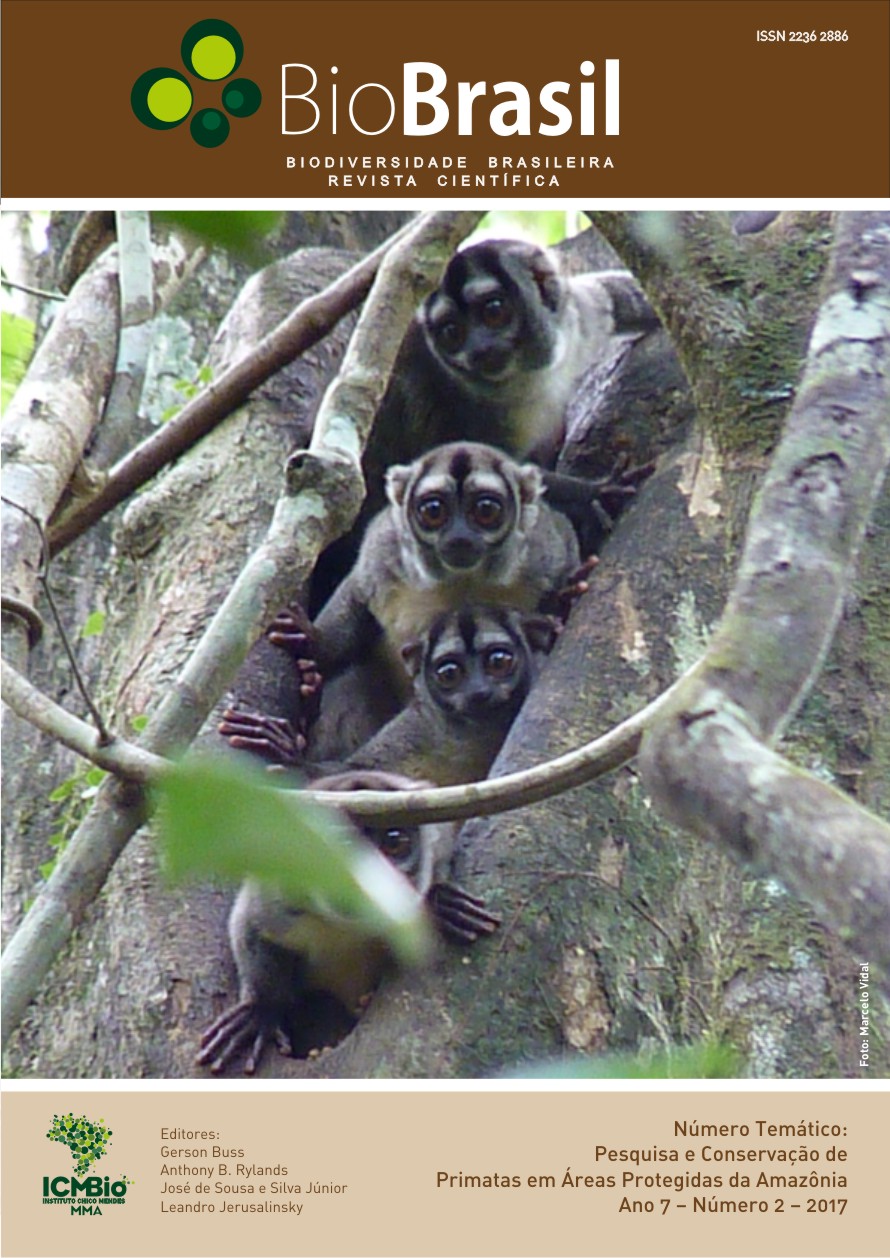<b> Primates in three protected areas in the middle Solimões basin, Brazilian Amazon / Primatas em três unidades de conservação na bacia do médio Rio Solimões, amazônia brasileira </b>
DOI:
https://doi.org/10.37002/biodiversidadebrasileira.v7i2.649Resumo
The Amazon Rainforest is an example of a challenging scenario for the species inventories as a baseline for the Conservation actions. New Primate species are described in this Biome every year. However, the distribution and taxonomy of several taxa remain controversial, hampering the efforts for its conservation. In this sense, the species inventory is one of the essential points to consolidate the management plans in Protected Areas. Here we report the Primates inventories Protected Areas in the middle Solimões River, Amazon. We surveyed two PAs of Sustainable Use, Jutaí Extractivist Reserve (RESEX Jutaí) and Auati-Paraná Extractivist Reserve (RESEX Auati-Paraná), and a Strict Protection, Rio Jutaí Ecological Station (ESEC - Rio Jutaí). We updated the occurrence and distribution of the Primates taxa contributing to the species list of management plans for these areas. This project is a partnership between Chico Mendes Institute for Biodiversity Conservation (ICMBio) and Mamirauá Institute for Sustainable Development (IDSM) (Termo de Reciprocidade 05/2012). In 2014 and 2015, we collected data in the ESEC Jutai-Solimões and RESEX Rio Jutaí during 35 days in three expeditions. We collected data during 24 days in the RESEX Auati-Paraná in April 2015, in the wet season. We used rapid survey methods for mammals inventories including surveys along existing trails, specimens collection, and semi-structured interviews with local inhabitants. The material collected was stored in the Mammal Collection of Mamirauá Institute (SISBIO 42111-1; 42111-2; 42111-3). The three PAs represents a total of 22 Primates species and subspecies from 14 genera. The ESEC Jutai-Solimoes and RESEX Rio Jutai has, respectively, 11 and 13 primate taxa confirmed. The RESEX Auati-Parana has 9 Primate taxa confirmed. The records presented here are an important start point to understanding the Primate diversity in PAs of middle Solimões. RESUMO O inventário de espécies é um dos pontos essenciais para consolidar os planos de manejo em áreas protegidas. Neste trabalho, apresentamos o resultado dos inventários de primatas em áreas protegidas (APs) no médio rio Solimões, Amazonas. Nós amostramos duas APs de uso sustentável - a Reserva Extrativista Rio Jutaí (RESEX Rio Jutaí) e a Reserva Extrativista Auatí-Paraná (RESEX Auatí-Paraná) - e uma estação ecológica (ESEC Jutaí-Solimões). Atualizamos a ocorrência e distribuição de primatas nessas áreas contribuindo para a lista de espécies dos planos de gestão. Em 2014 e 2015, coletamos dados na ESEC Jutaí-Solimões e RESEX Rio Jutaí durante 35 dias em três expedições. Foram coletados dados durante 24 dias na RESEX Auatí-Paraná em abril de 2015, na estação chuvosa. Os levantamentos foram realizados em trilhas previamente existentes, sendo a amostragem nas florestas alagadas realizada com canoas. Os registros apresentados aqui foram baseados em avistamentos ou na coleta de espécimes, quando necessária. O material coletado foi depositado no Acervo de Mamíferos do Instituto de Desenvolvimento Sustentável Mamirauá. Registrou-se um total de 22 espécies e subespécies pertencentes a 14 gêneros nas três APs. A ESEC Jutaí-Solimões e a RESEX Rio Jutaí possuem, respectivamente, 11 e 13 táxons confirmados, enquanto a RESEX Auatí-Paraná possui sete táxons. Os registros aqui apresentados são um ponto de partida importante para o entendimento da diversidade de primatas em APs do médio Solimões.Downloads
Publicado
2018-05-13
Edição
Seção
Primatas Amazônicos
Licença
Os artigos estão licenciados sob uma licença Creative Commons Atribuição-NãoComercial-SemDerivações 4.0 Internacional (CC BY-NC-ND 4.0). O acesso é livre e gratuito para download e leitura, ou seja, é permitido copiar e redistribuir o material em qualquer mídia ou formato.











